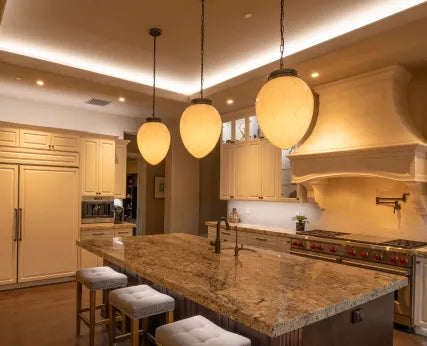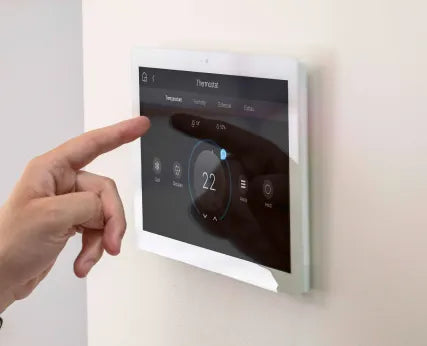From Smart Home to Smart Living: Building Your Own Automated Home
Imagine this: on your way home, your smart thermostat has already set the temperature just the way you like it. As you step inside, smart lighting gradually brightens to welcome you. With a simple "I'm home," your favorite music starts and the curtains draw themselves closed. This isn't a scene from a sci-fi film—it's what an automated home can deliver today.
"Smart home" has evolved from a handful of smart devices into a connected, integrated ecosystem. It's no longer just about remote control; it's about your home anticipating your needs and acting for you. So, what separates a truly automated home from one filled with random gadgets?
The answer: integration and intelligence. A home automation system brings all your devices together, creating a seamless, convenient, and efficient living experience. This guide will show you how to transform your living space from simply "connected" to genuinely "smart"—making your life easier, safer, and more energy-efficient.
What Is an Automated Home and How Does It Work?
An automated home, also called smart home automation, involves connecting your home's devices and systems to a central network, enabling them to communicate and carry out actions based on preset rules, schedules, or real-time data.
The core of this system is the home hub and communication protocols like Zigbee, Z-Wave, and the emerging Matter standard. These technologies build a robust network to let smart devices—from lighting, locks, thermostats, to cameras—work together smoothly.
Unlike operating each device manually, automated homes can:
- Detect your presence using occupancy sensors or geofencing (your phone's location).
- Execute scenes or routines—at a tap, the "Goodnight" scene can turn off all lights, lock doors, and adjust the thermostat.
- Respond to your commands via voice control assistants such as Alexa and Google Assistant.
- Proactively manage energy efficiency by turning devices off when not needed.
In short, your home becomes a thoughtful companion that can think and act for you.
Key Benefits of an Automated Home
Upgrading to a smart home brings more than convenience—it creates lasting value for homeowners and property managers.
- Unmatched Comfort and Convenience: Home automation takes care of daily chores, giving you more time to enjoy life.
- Notable Energy Savings: By intelligently managing lighting, heating, and cooling—especially during peak rate times—automation can dramatically lower energy bills.
- Enhanced Home Security: Integrated smart locks, smart cameras, and sensors form an active home security network, delivering instant alerts at the first sign of threat.
- Improved Quality of Life: From better indoor air quality to immersive whole-home audio, automated homes elevate nearly every aspect of daily living.
- Care and Accessibility: For seniors or those with limited mobility, features like voice control and automated lighting promote safety and independence.
Core Components of a Home Automation System
A robust home automation system consists of several key elements.
- Home Hub & Protocols: This is the brain. The hub coordinates all devices, while Zigbee, Z-Wave, Wi‑Fi, and Matter protocols serve as the language connecting everything.
- Reliable Network: A strong, stable Wi‑Fi network is the foundation for all wireless smart devices to work seamlessly.
- Smart Devices: The system’s "hands and feet"—including:
-
- Smart Lighting: Adjusts brightness, color, and on/off schedules.
- Smart Thermostat: Optimizes heating and cooling.
- Smart Locks & Doorbells: Remotely control entry and monitor visitors.
- Smart Cameras: Provide real-time monitoring and smart alerts.
- Smart Shades/Blinds: Open and close based on time of day or solar intensity.
- Sensors: Detect motion, door/window status, water leaks, and smoke.
Top Use Cases: Automation in Everyday Life
The real magic of smart home automation lies in how it adapts to every aspect of your life.
Comfort and Convenience
Picture a "Good Morning" scene: 15 minutes before you wake, the curtains gently pull open, the thermostat turns up, the coffee maker starts, and the news briefing plays through your smart speaker.
Security and Protection
Heading out? Your system automatically locks the doors, arms security, and switches off unnecessary lights. If a smart camera spots unusual activity, it sends your phone an alert and turns on all lights to deter intruders.
Energy Management
The system smartly manages power use based on your occupancy, time of day, or even real-time energy prices—like dimming lights during peak rates or scheduling EV charging at night when rates are lower.
Entertainment Experience
With a “Movie Night” scene, you can dim the lights, drop the projector screen, and fire up the sound system—all at once. Your whole-home audio can follow you seamlessly from room to room.
Quick Poll: Which automated scene are you most excited to make real in your home—an "away mode" or "movie night"?
Deep Dive: Key Features
- Voice Control: The most natural way to interact—simple commands can control a single device or trigger an entire scene.
- Routines & Scenes: The heart of automation. Schedule custom routines so a group of actions happen together—triggered by time, sensor status, or your location.
- Presence Sensing: The system uses occupancy sensors and geofencing to detect who's home and in which room, adapting settings accordingly.
- Scheduling: Automate daily tasks (like a smart irrigation system for your garden).
- Unified Dashboard: Monitor and control everything via a mobile app or a wall-mounted touchscreen interface.
Integration and Interoperability: Making Everything Work Together
In the past, different brands of devices often wouldn’t talk to each other. That’s changing fast.
- Matter: An emerging industry standard that enables devices from different brands to work together right out of the box—making setup and expansion far easier.
- Zigbee/Z-Wave: Established low-power wireless protocols, these are designed for smart home gadgets and form resilient mesh networks.
- Wi‑Fi: Many devices connect directly to your Wi‑Fi for hassle-free setup, though too many can bog down your network.
Pro Tip: When building your system, choose a home hub that supports multiple protocols—especially Matter—to maximize future compatibility.
Privacy and Cybersecurity: Protecting Your Smart Home
A connected home brings added responsibility for personal data and privacy.
- Change Default Passwords: This is your first and most important defense.
- Enable Two-Factor Authentication: Adds an extra layer of security for your main accounts.
- Create a Separate Device Network: Set up a guest Wi‑Fi for smart gadgets, isolating them from your main private network.
- Update Firmware Regularly: Manufacturers release firmware updates to patch security gaps—keep everything current.
Checklist: Review your existing smart devices and make sure each one has a unique, strong password.
The Future of Automated Homes
Home automation tech is advancing at lightning speed.
- Edge AI: More smart decisions are made on the device itself, not in the cloud, delivering faster responses and better privacy.
- Predictive Maintenance: Your home will alert you when the air filter needs replacing—or even predict a water heater failure before it happens.
- Energy Orchestration: Systems will coordinate more intelligently with the grid, tapping solar panels, home batteries, and EVs to optimize energy production, storage, and usage throughout the day.
Partner with Linko Smart Technology
Designing and installing a seamless, reliable, and secure home automation system takes deep experience. From network planning and device selection to complex scene programming, every detail matters.
At Linko Smart Technology, we’re end-to-end smart home specialists. We start by getting to know your lifestyle and needs, then tailor a custom system, deliver professional installation and setup, and make sure you’re comfortable enjoying all the benefits of smart living.
Ready to transform your house into a truly intelligent partner? Contact Linko Smart Technology for a free consultation or to start planning your automated home project.
Frequently Asked Questions (FAQ)
1. How much does a full home automation system cost?
Costs vary widely based on home size, number and brand of devices, and system complexity. You can start with a single room or feature (like smart lighting) and expand gradually.
2. Can my old house be upgraded for automation?
Absolutely. The market is full of wireless devices and solutions designed for existing homes—no major rewiring needed.
3. How long does installation take?
A basic system (thermostat and a couple of lights) might take just a few hours. Whole-home projects can take several days, depending on complexity and size.
4. What maintenance is required?
Most modern smart home devices require almost no physical maintenance. Mainly, you'll need to keep software and firmware updated—something apps can usually do automatically.
5. DIY vs. professional install: how should I choose?
DIY installation is great for handy tech enthusiasts looking to add a few standalone devices. But for a fully integrated, rock-solid whole-home system—where devices work in sync—we strongly recommend professional installation. Pros ensure compatible networking, device integration, and advanced scene programming.
6. Is my personal data and privacy safe?
We make privacy a top priority. We select only reputable brands with robust cybersecurity features and transparent privacy policies. Professional install includes all necessary measures to safeguard your system against unauthorized access.




